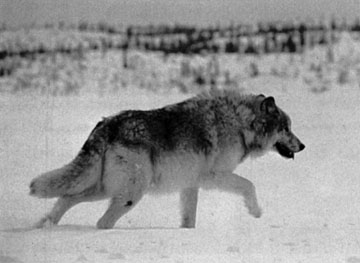|
by Kristin DeBoer Over the last decade, a wolf recovery movement has swept the nation. The successful re-establishment of wolves into Yellowstone and Central Idaho has inspired wildlife lovers everywhere. Thousands of people visit the Great Lakes just to experience the thrill of wildness which wolves bring to the forest. Mexican wolves have been reintroduced to the Southwest and red wolves are back in the Southeast, where they struggle to recover from the brink of extinction. Across the country, the return of the wolf is helping restore diversity and wholeness within the great web of life. For years, people in the Northeast have provided much of the public support for wolf recovery programs elsewhere. But until recently the idea of wolves in our own backyard was just a wild dream. Now, after almost seven years of public education and outreach, there is an exciting momentum to restore the howl of the wolf to the North Woods of Maine, New Hampshire, Vermont, and New York.  For thousands of years, the eastern timber wolf lived throughout the forests of the Northeast, including Maine. But in the 1600s, colonists began to clear the land for agriculture. In the process wolves were cleared out too. Whole packs were shot, trapped, poisoned, and burned, until the last wolf was driven from the region by the turn of the century. But, as the economy of New England has changed, so has the land. In the last hundred years, the forests have been re-greening old pastures. Moose, deer, and beaver, once scarce, are recovering. So far, large tracts of remote forest have escaped threats of development in the Maine Woods, the White Mountains of New Hampshire, the Northeast Kingdom of Vermont, and the Adirondack State Park of New York. All this provides enough remote habitat, with an abundant prey base, scarce human population, and low road density to support 1,000-2,000 wolves-mostly in the vast North Woods of Maine. As the land has become more wild, our ideas about wolves have changed too. Several public opinion polls have shown that the majority of citizens believe that the wolf has a right to exist in this region. Over 200,000 people have signed petitions in support of the effort. Hundreds of educational presentations and three key conferences in Maine, New Hampshire, and New York have reached thousands of people. Over thirty local, regional, and national conservation organizations have formed the Coalition to Restore the Eastern Wolf (CREW) to coordinate research, education, and advocacy efforts. In response to this surge of public interest, the U.S. Fish and Wildlife Service has promised to begin developing a wolf recovery plan for the Northeast in 2000. This is a giant step forward. The plan will create a blueprint for wolf restoration by identifying the tasks, agencies, and funding necessary for achieving recovery. However, a plan does not guarantee action. That will depend on whether the public is supportive. In order to make an informed decision about if and how to encourage wolf recovery, the planning process will fully involve citizens, state agencies, and landowners through hearings and comment periods. Yet, as the wolf recovery movement builds momentum, there are bound to be detractors. Already opponents in New Hampshire passed a law prohibiting wolf reintroduction. Now wolf-opponents are trying to do the same in Vermont. Maine could be next. Some people fear that wolves will attack their children, prey upon livestock, and decimate deer herds. Others fear that laws protecting wolves will "lock up the forest" and mean lost logging jobs. Regrettably, myths of the "big bad wolf" still persist. The truth is that there is not one good reason to fear the wolf. Experiences with wolf recovery in other parts of the country show that wolves do not pose any significant threat to people's livelihoods, pastimes, or safety. In fact, wolf recovery can benefit local economies by attracting ecotourism, and increase the health of prey populations, such as deer. Yet, given the prevalence and durability of these fears, ultimately a successful wolf recovery program will have to help people feel safe with the idea of wolves inhabiting the forest. This year will be a critical time for all
those concerned about the ecological health of the North Woods
to take up the call for the wolf. The land is ready for the wolf's
return, ready to reweave one more strand in the ecosystem that
is the revival of this region's biodiversity. But this will only
happen if the people of this region choose to welcome the wolf
home. RESTORE: The North Woods: Kristin DeBoer |